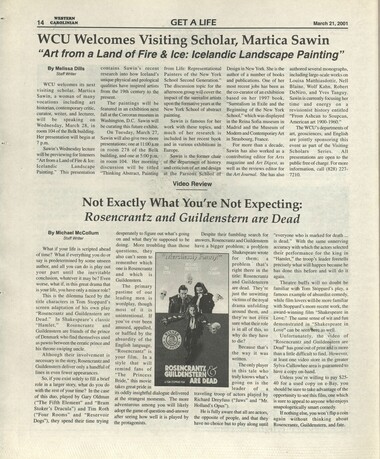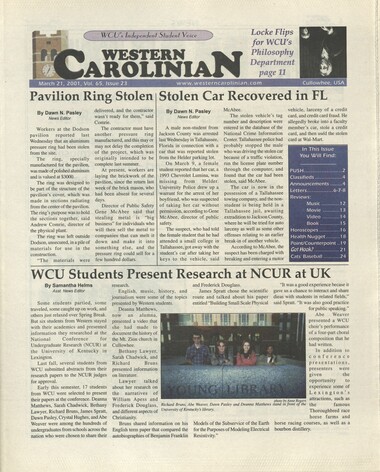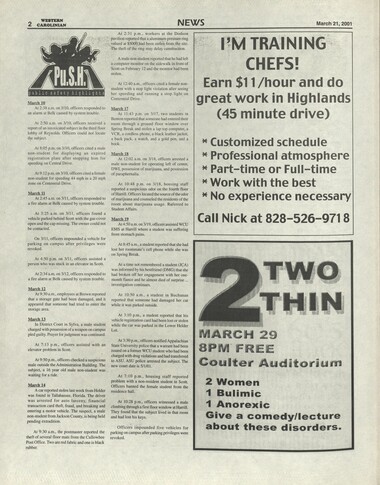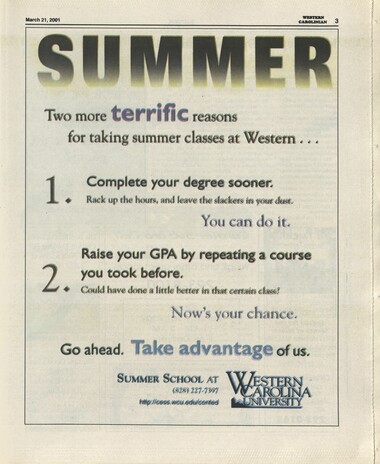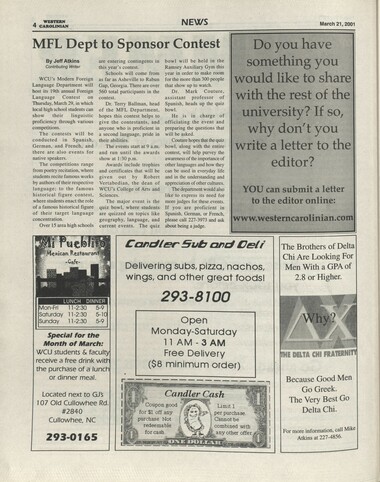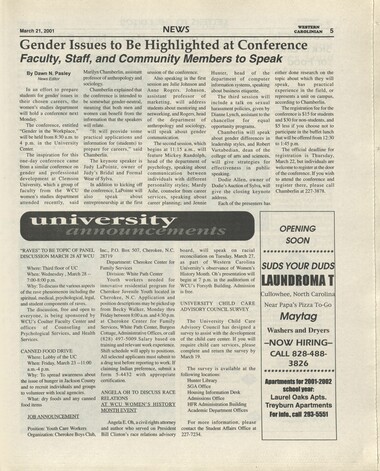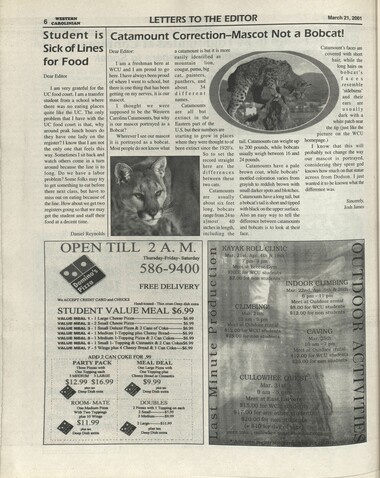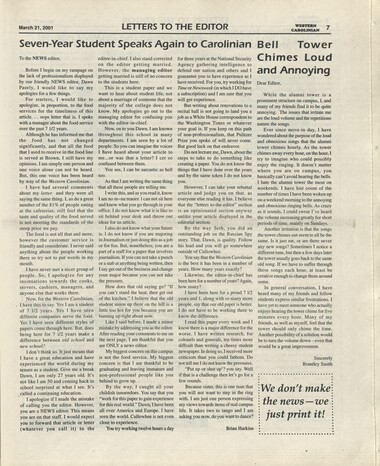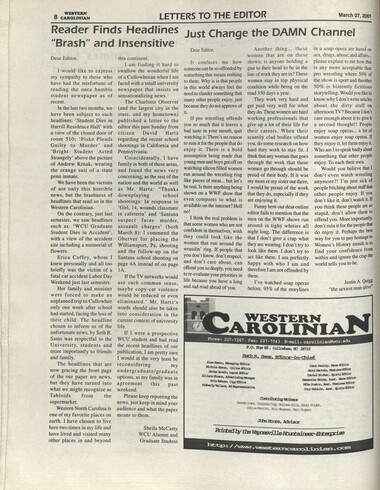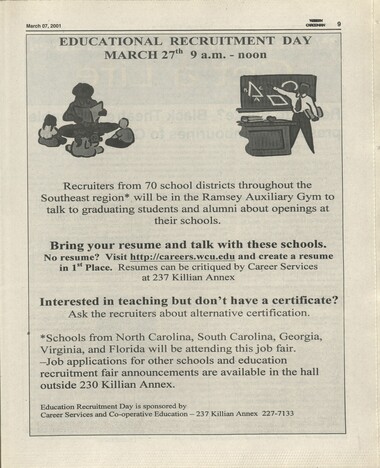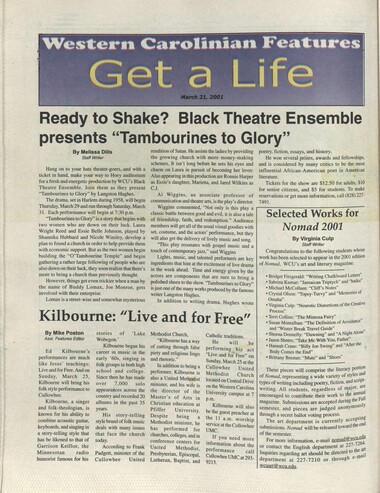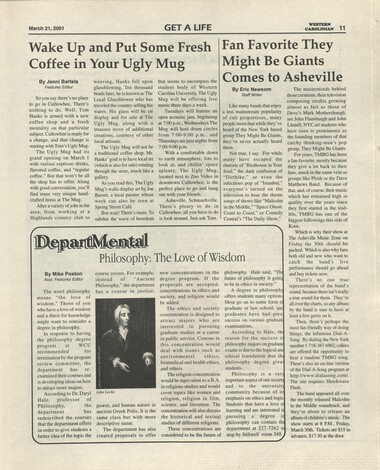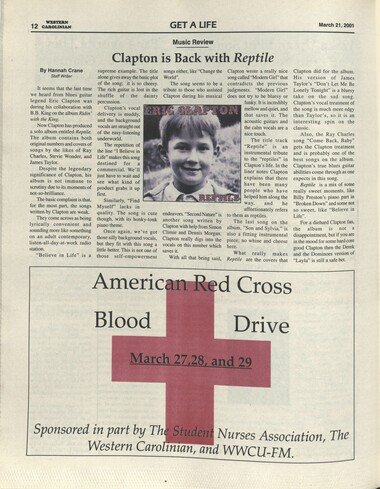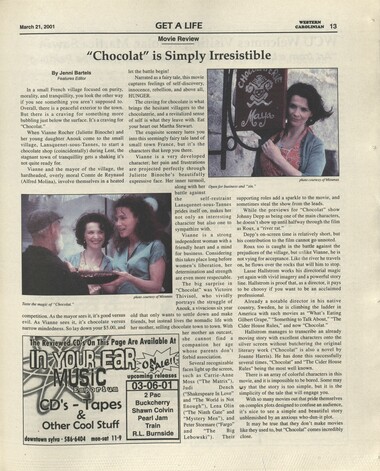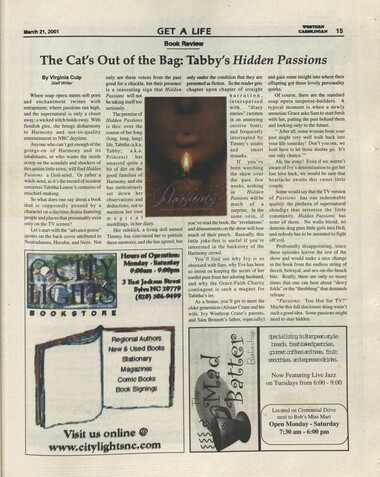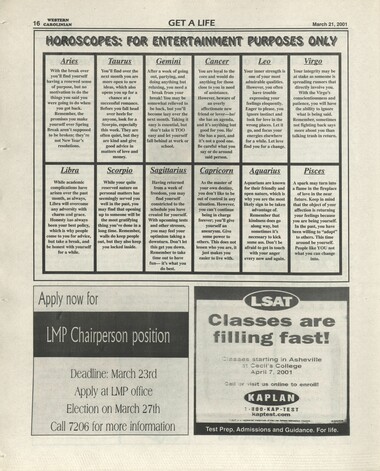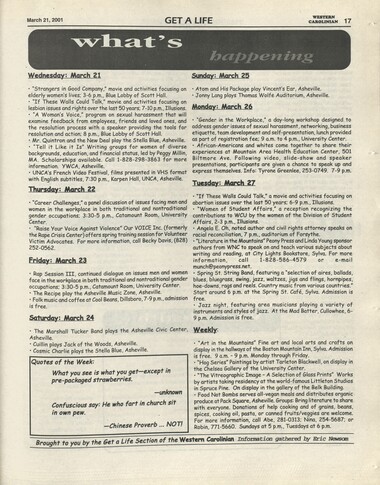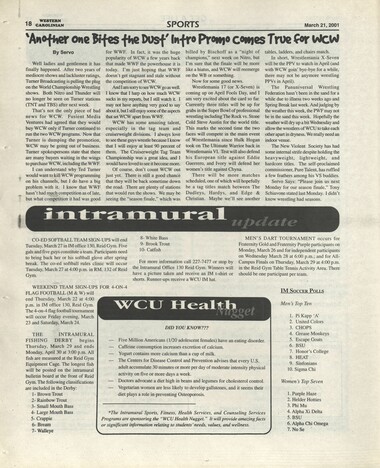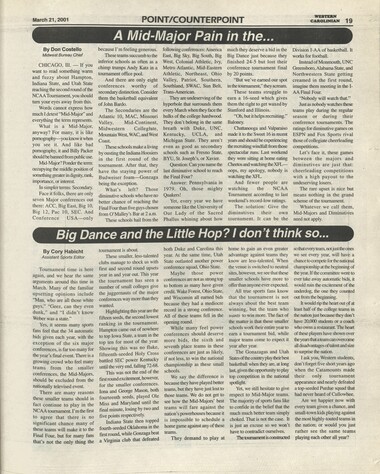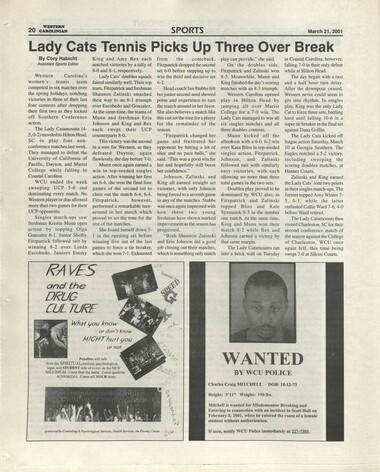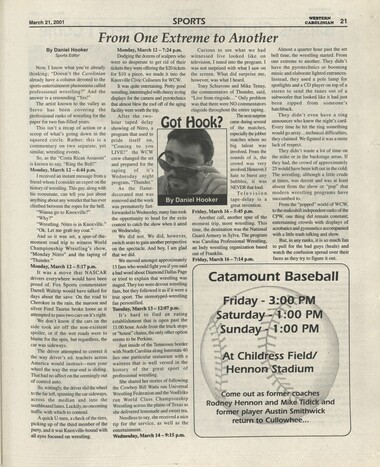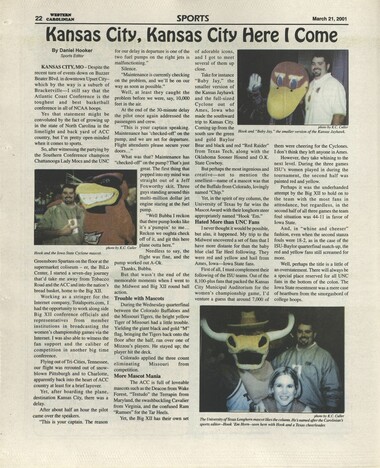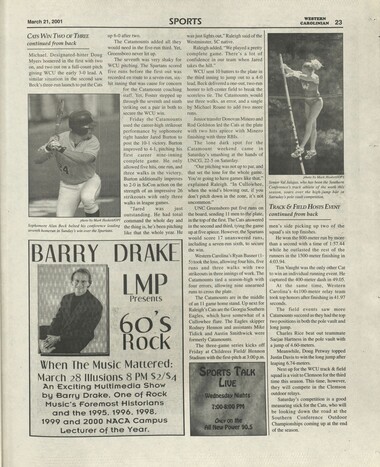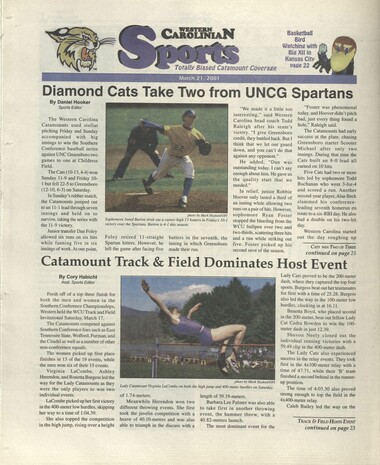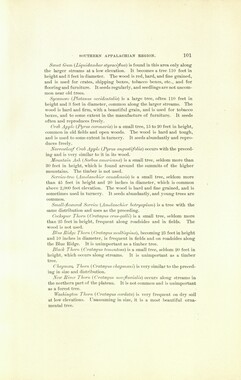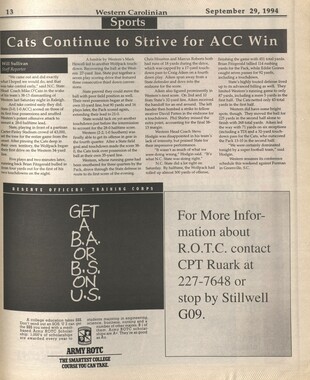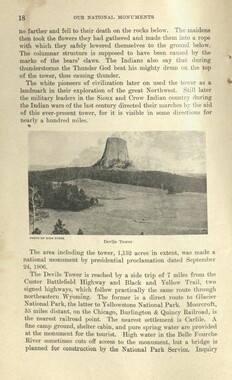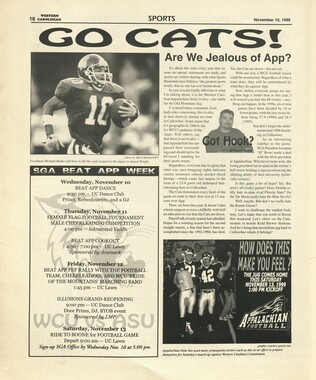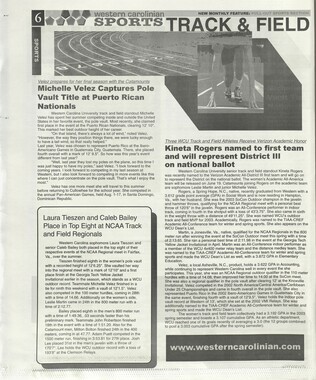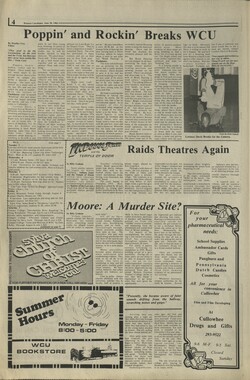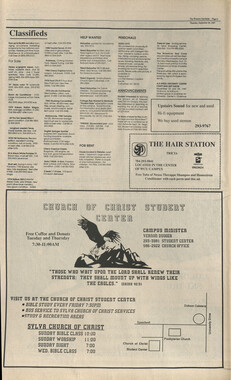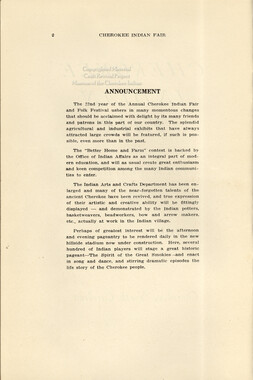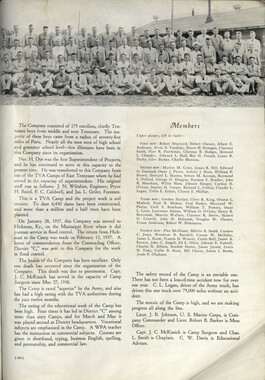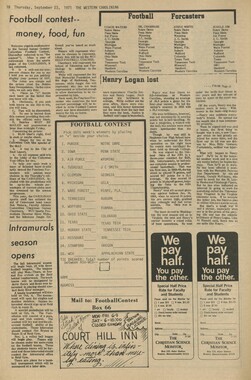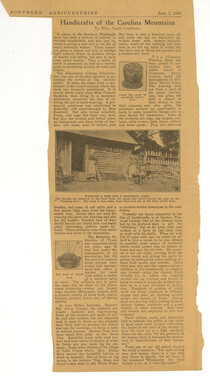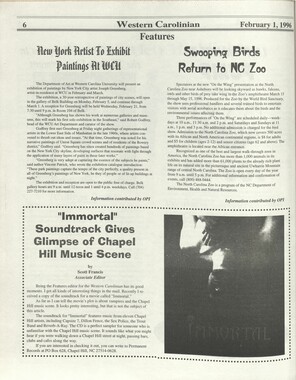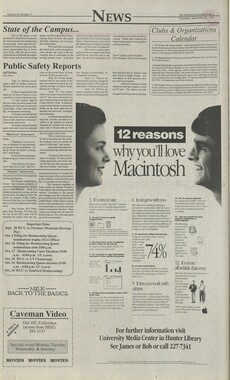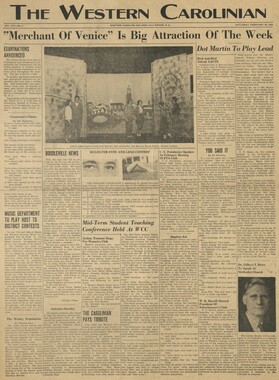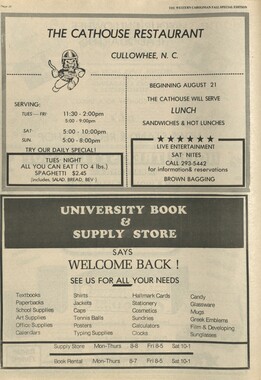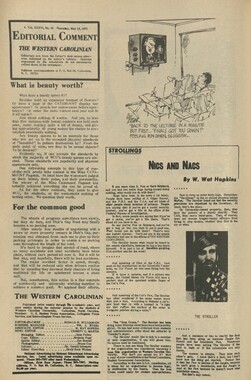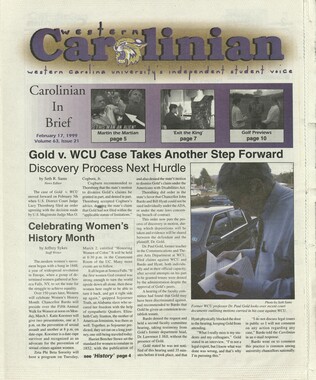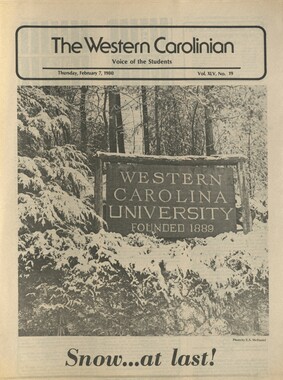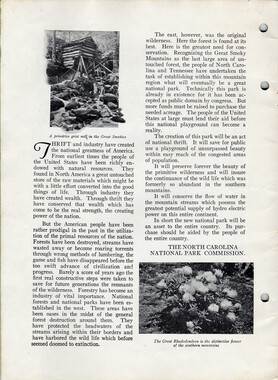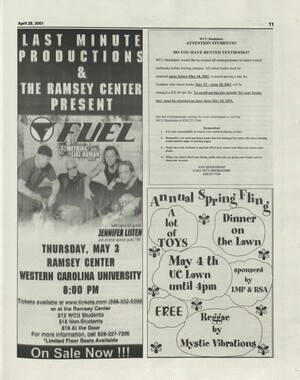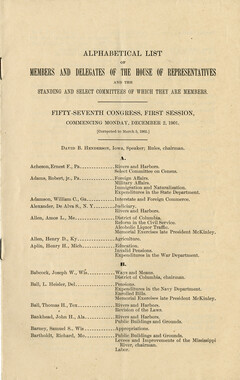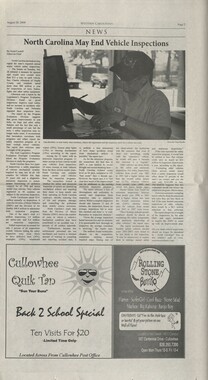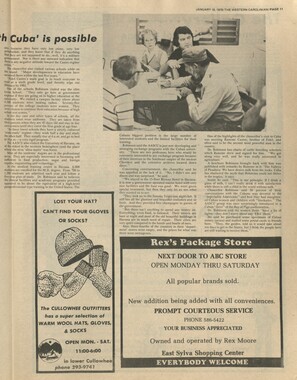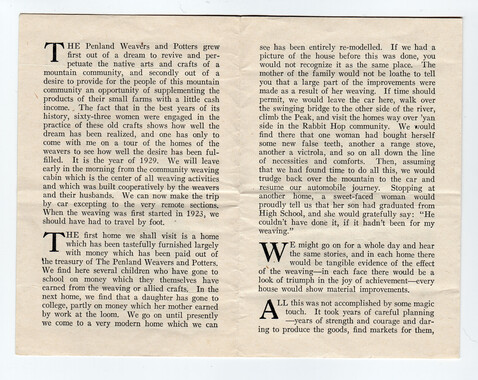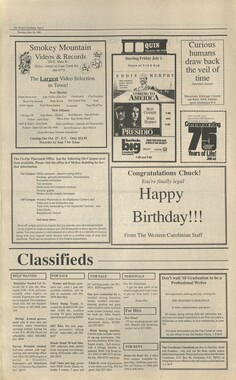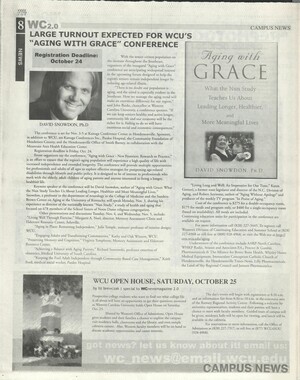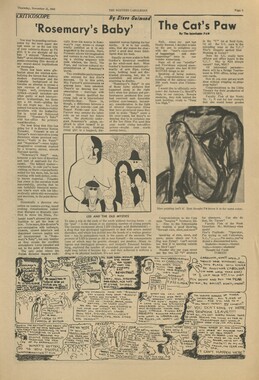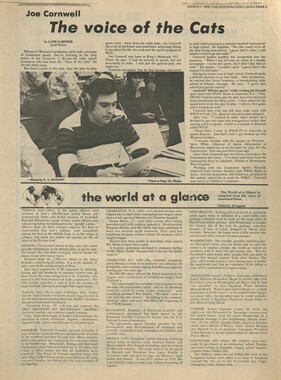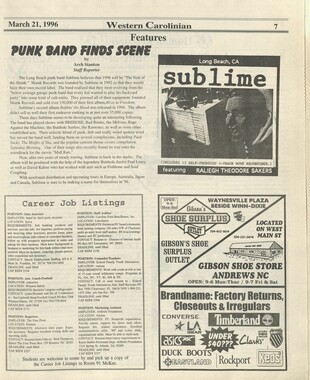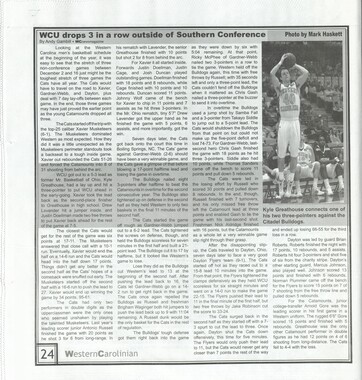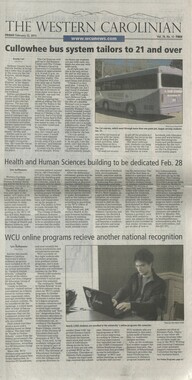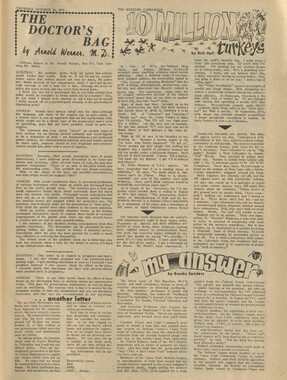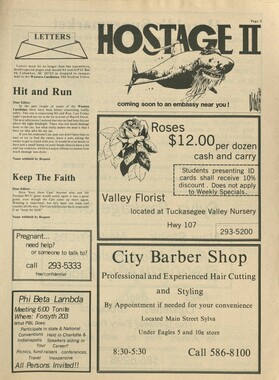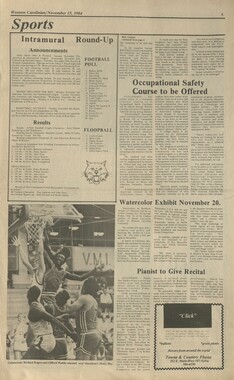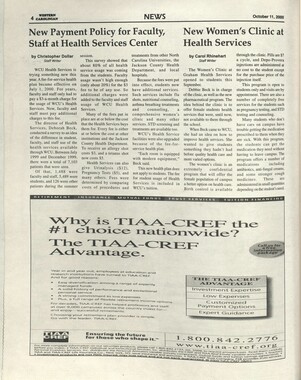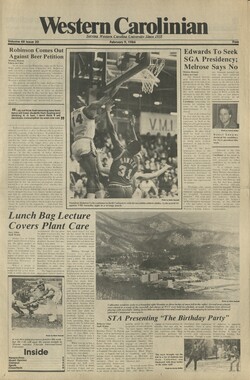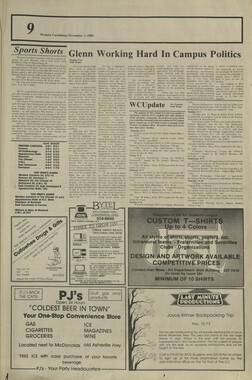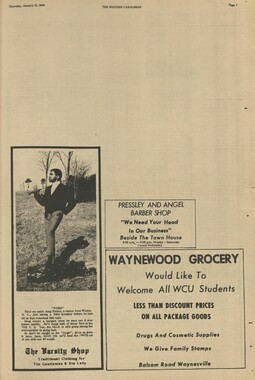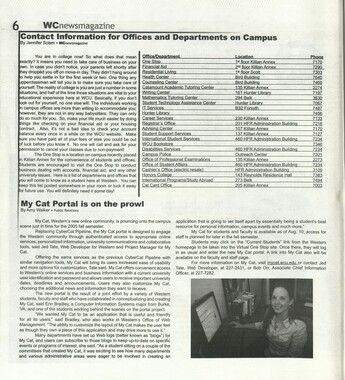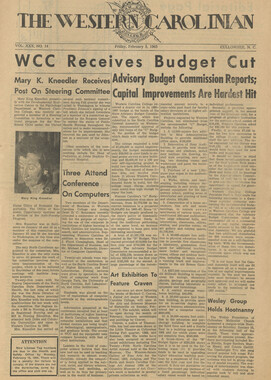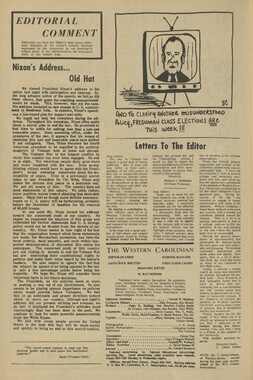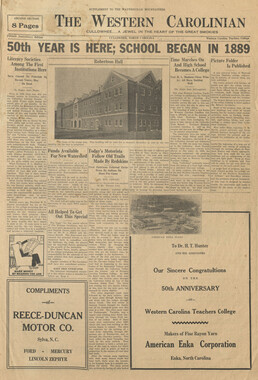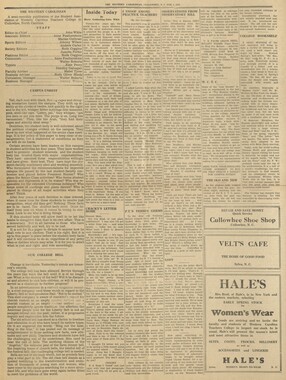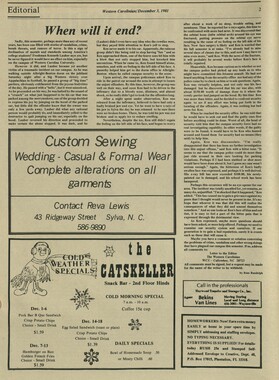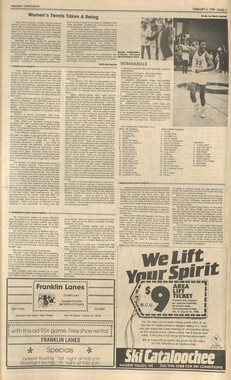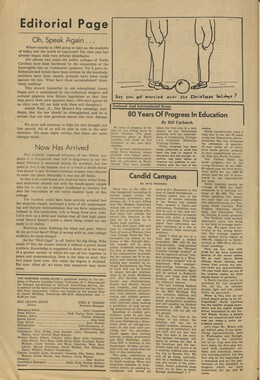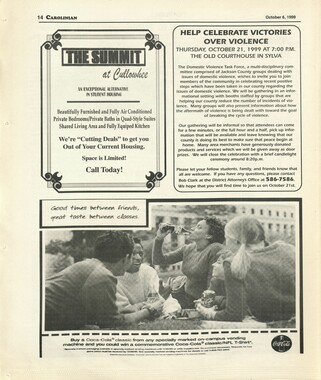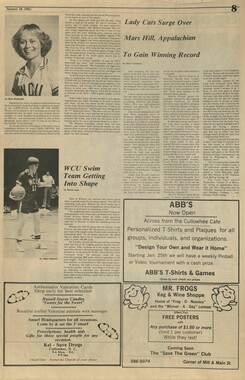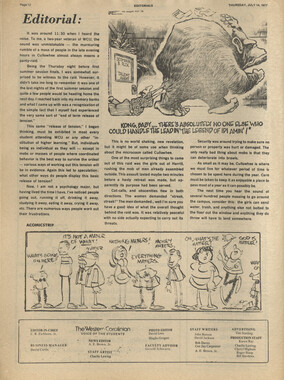Western Carolina University (20)
View all
- Canton Champion Fibre Company (2308)
- Cherokee Traditions (291)
- Civil War in Southern Appalachia (165)
- Craft Revival (1942)
- Great Smoky Mountains - A Park for America (2946)
- Highlights from Western Carolina University (430)
- Horace Kephart (941)
- Journeys Through Jackson (159)
- LGBTQIA+ Archive of Jackson County (85)
- Oral Histories of Western North Carolina (314)
- Picturing Appalachia (6873)
- Stories of Mountain Folk (413)
- Travel Western North Carolina (160)
- Western Carolina University Fine Art Museum Vitreograph Collection (129)
- Western Carolina University Herbarium (92)
- Western Carolina University: Making Memories (738)
- Western Carolina University Publications (2488)
- Western Carolina University Restricted Electronic Theses and Dissertations (146)
- Western North Carolina Regional Maps (71)
- World War II in Southern Appalachia (131)
University of North Carolina Asheville (6)
View all
- Allanstand Cottage Industries (62)
- Appalachian National Park Association (53)
- Bennett, Kelly, 1890-1974 (1463)
- Berry, Walter (76)
- Brasstown Carvers (40)
- Carver, George Washington, 1864?-1943 (26)
- Cathey, Joseph, 1803-1874 (1)
- Champion Fibre Company (233)
- Champion Paper and Fibre Company (297)
- Cherokee Indian Fair Association (16)
- Cherokee Language Program (22)
- Crowe, Amanda (40)
- Edmonston, Thomas Benton, 1842-1907 (7)
- Ensley, A. L. (Abraham Lincoln), 1865-1948 (275)
- Fromer, Irving Rhodes, 1913-1994 (70)
- George Butz (BFS 1907) (46)
- Goodrich, Frances Louisa (120)
- Grant, George Alexander, 1891-1964 (96)
- Heard, Marian Gladys (60)
- Kephart, Calvin, 1883-1969 (15)
- Kephart, Horace, 1862-1931 (313)
- Kephart, Laura, 1862-1954 (39)
- Laney, Gideon Thomas, 1889-1976 (439)
- Masa, George, 1881-1933 (61)
- McElhinney, William Julian, 1896-1953 (44)
- Niggli, Josephina, 1910-1983 (10)
- North Carolina Park Commission (105)
- Osborne, Kezia Stradley (9)
- Owens, Samuel Robert, 1918-1995 (11)
- Penland Weavers and Potters (36)
- Roberts, Vivienne (15)
- Roth, Albert, 1890-1974 (142)
- Schenck, Carl Alwin, 1868-1955 (1)
- Sherrill's Photography Studio (2565)
- Southern Highland Handicraft Guild (127)
- Southern Highlanders, Inc. (71)
- Stalcup, Jesse Bryson (46)
- Stearns, I. K. (213)
- Thompson, James Edward, 1880-1976 (226)
- United States. Indian Arts and Crafts Board (130)
- USFS (683)
- Vance, Zebulon Baird, 1830-1894 (1)
- Weaver, Zebulon, 1872-1948 (58)
- Western Carolina College (230)
- Western Carolina Teachers College (282)
- Western Carolina University (2005)
- Western Carolina University. Mountain Heritage Center (18)
- Whitman, Walt, 1819-1892 (10)
- Wilburn, Hiram Coleman, 1880-1967 (73)
- Williams, Isadora (3)
- Cain, Doreyl Ammons (0)
- Crittenden, Lorraine (0)
- Rhodes, Judy (0)
- Smith, Edward Clark (0)
- Appalachian Region, Southern (2569)
- Asheville (N.C.) (1923)
- Avery County (N.C.) (26)
- Blount County (Tenn.) (195)
- Buncombe County (N.C.) (1672)
- Cherokee County (N.C.) (283)
- Clay County (N.C.) (555)
- Graham County (N.C.) (236)
- Great Smoky Mountains National Park (N.C. and Tenn.) (519)
- Haywood County (N.C.) (3569)
- Henderson County (N.C.) (70)
- Jackson County (N.C.) (4909)
- Knox County (Tenn.) (35)
- Knoxville (Tenn.) (13)
- Lake Santeetlah (N.C.) (10)
- Macon County (N.C.) (420)
- Madison County (N.C.) (215)
- McDowell County (N.C.) (39)
- Mitchell County (N.C.) (132)
- Polk County (N.C.) (35)
- Qualla Boundary (982)
- Rutherford County (N.C.) (76)
- Swain County (N.C.) (2182)
- Transylvania County (N.C.) (270)
- Watauga County (N.C.) (12)
- Waynesville (N.C.) (86)
- Yancey County (N.C.) (72)
- Aerial Photographs (3)
- Aerial Views (60)
- Albums (books) (4)
- Articles (1)
- Artifacts (object Genre) (228)
- Bibliographies (1)
- Biography (general Genre) (2)
- Cards (information Artifacts) (38)
- Clippings (information Artifacts) (191)
- Copybooks (instructional Materials) (3)
- Crafts (art Genres) (622)
- Depictions (visual Works) (21)
- Design Drawings (1)
- Drawings (visual Works) (185)
- Envelopes (73)
- Exhibitions (events) (1)
- Facsimiles (reproductions) (1)
- Fiction (general Genre) (4)
- Financial Records (12)
- Fliers (printed Matter) (67)
- Glass Plate Negatives (381)
- Guidebooks (2)
- Internegatives (10)
- Interviews (815)
- Land Surveys (102)
- Letters (correspondence) (1013)
- Manuscripts (documents) (618)
- Maps (documents) (177)
- Memorandums (25)
- Minutes (administrative Records) (59)
- Negatives (photographs) (6090)
- Newsletters (1290)
- Newspapers (2)
- Notebooks (8)
- Occupation Currency (1)
- Paintings (visual Works) (1)
- Pen And Ink Drawings (1)
- Periodicals (193)
- Personal Narratives (10)
- Photographs (12976)
- Plans (maps) (1)
- Poetry (5)
- Portraits (4568)
- Postcards (329)
- Programs (documents) (181)
- Publications (documents) (2440)
- Questionnaires (65)
- Relief Prints (26)
- Sayings (literary Genre) (1)
- Scrapbooks (282)
- Sheet Music (2)
- Slides (photographs) (402)
- Songs (musical Compositions) (2)
- Sound Recordings (796)
- Specimens (92)
- Speeches (documents) (18)
- Tintypes (photographs) (8)
- Transcripts (322)
- Video Recordings (physical Artifacts) (23)
- Text Messages (0)
- A.L. Ensley Collection (275)
- Appalachian Industrial School Records (7)
- Appalachian National Park Association Records (336)
- Axley-Meroney Collection (2)
- Bayard Wootten Photograph Collection (20)
- Bethel Rural Community Organization Collection (7)
- Blumer Collection (5)
- C.W. Slagle Collection (20)
- Canton Area Historical Museum (2110)
- Carlos C. Campbell Collection (462)
- Cataloochee History Project (64)
- Cherokee Studies Collection (4)
- Daisy Dame Photograph Album (5)
- Daniel Boone VI Collection (1)
- Doris Ulmann Photograph Collection (112)
- Elizabeth H. Lasley Collection (1)
- Elizabeth Woolworth Szold Fleharty Collection (4)
- Frank Fry Collection (95)
- George Masa Collection (173)
- Gideon Laney Collection (452)
- Hazel Scarborough Collection (2)
- Hiram C. Wilburn Papers (28)
- Historic Photographs Collection (236)
- Horace Kephart Collection (861)
- Humbard Collection (33)
- Hunter and Weaver Families Collection (1)
- I. D. Blumenthal Collection (4)
- Isadora Williams Collection (4)
- Jesse Bryson Stalcup Collection (47)
- Jim Thompson Collection (224)
- John B. Battle Collection (7)
- John C. Campbell Folk School Records (80)
- John Parris Collection (6)
- Judaculla Rock project (2)
- Kelly Bennett Collection (1482)
- Love Family Papers (11)
- Major Wiley Parris Civil War Letters (3)
- Map Collection (12)
- McFee-Misemer Civil War Letters (34)
- Mountain Heritage Center Collection (4)
- Norburn - Robertson - Thomson Families Collection (44)
- Pauline Hood Collection (7)
- Pre-Guild Collection (2)
- Qualla Arts and Crafts Mutual Collection (12)
- R.A. Romanes Collection (681)
- Rosser H. Taylor Collection (1)
- Samuel Robert Owens Collection (94)
- Sara Madison Collection (144)
- Sherrill Studio Photo Collection (2558)
- Smoky Mountains Hiking Club Collection (616)
- Stories of Mountain Folk - Radio Programs (374)
- The Reporter, Western Carolina University (510)
- Venoy and Elizabeth Reed Collection (16)
- WCU Gender and Sexuality Oral History Project (32)
- WCU Mountain Heritage Center Oral Histories (25)
- WCU Oral History Collection - Mountain People, Mountain Lives (71)
- WCU Students Newspapers Collection (1920)
- Western North Carolina Tomorrow Black Oral History Project (69)
- William Williams Stringfield Collection (2)
- Zebulon Weaver Collection (109)
- African Americans (390)
- Appalachian Trail (35)
- Artisans (521)
- Cherokee art (84)
- Cherokee artists -- North Carolina (10)
- Cherokee language (21)
- Cherokee pottery (101)
- Cherokee women (208)
- Church buildings (189)
- Civilian Conservation Corps (U.S.) (111)
- College student newspapers and periodicals (2009)
- Dams (107)
- Dance (1023)
- Education (222)
- Floods (61)
- Folk music (1015)
- Forced removal, 1813-1903 (2)
- Forest conservation (220)
- Forests and forestry (1184)
- Gender nonconformity (4)
- Great Smoky Mountains National Park (N.C. and Tenn.) (181)
- Hunting (45)
- Landscape photography (25)
- Logging (119)
- Maps (83)
- Mines and mineral resources (8)
- North Carolina -- Maps (18)
- Paper industry (38)
- Postcards (255)
- Pottery (135)
- Railroad trains (72)
- Rural electrification -- North Carolina, Western (3)
- School integration -- Southern States (2)
- Segregation -- North Carolina, Western (5)
- Slavery (5)
- Sports (452)
- Storytelling (243)
- Waterfalls -- Great Smoky Mountains (N.C. and Tenn.) (66)
- Weaving -- Appalachian Region, Southern (280)
- Wood-carving -- Appalachian Region, Southern (328)
- World War, 1939-1945 (173)
Western Carolinian Volume 65 (66) Number 23 (24)
Item
Item’s are ‘child’ level descriptions to ‘parent’ objects, (e.g. one page of a whole book).
-
-
14 WESTERN CAROLINIAN GET A LIFE March 21, 2001 WCU Welcomes Visiting Scholar, Martica Sawin "Art from a Land of Fire & Ice: Icelandic Landscape Painting ■■ By Melissa Dills Staff Writer WCU welcomes its next visiting scholar. Martica Sawin, a woman of many vocations including art historian, contemporary critic, curator, writer, and lecturer, will be speaking on Wednesday, March 28, in room 104 of the Belk building. Her presentation will begin at 7 p.m. Sawin's Wednesday lecture will be previewing for listeners "Art from a Land of Fire & Ice: Icelandic Landscape Painting." This presentation contains Sawin's recent research into how Iceland's unique physical and geological qualities have inspired artists from the 19th century to the present. The paintings will be featured in an exhibition next fall at the Corcoran museum in Washington, D.C. Sawin will be curating this future exhibit. On Tuesday, March 27, Sawin will also give two more presentations; one at 11:00 a.m in room 278 of the Belk building, and one at 5:00 p.m. in room 104. Her morning discussion will be titled "Thinking Abstract, Painting from Life: Representational Painters of the New York School Second Generation." The discussion topic for the afternoon group will cover the impact of the surrealist artists upon the formative years at the New York School of abstract painting. Sawin is famous for her work with these topics, and much of her research is included in her recent book and in various exhibitions in Europe. Sawin is the former chair of the department of history and criticism of art and design at the Parsons' School Of Video Review Design in New York. She is the author of a number of books and publications. One of her most recent jobs has been as the co-curator of an exhibition based on her 1997 book, "Surrealism in Exile and the Beginning of the New York School," which was displayed in the Reina Sofia museum in Madrid and the Museum of Modern and Contemporary Art in Strasbourg, France. For more than a decade, Sawin has also worked as a contributing editor for Arts magazine and Art Digest, as well as the reviews editor for the Art Journal. She has also authored several monographs, including large-scale works on Louisa Matthiasdottir, Nell Blaine, Wolf Kahn, Robert DeNiro, and Yves Tanguy. Sawin is currently focusing her time and energy on a revisionist history entitled "From Ashcan to Soupcan, American art 1900-1960." The WCU's departments of art, geosciences, and English are jointly sponsoring this event as part of the Visiting Scholars Series. . All presentations are open to the public free of charge. For more information, call (828) 227- 7210. Not Exactly What You're Not Expecting: Rosencrantz and Guildenstern are Dead By Michael McCollum Staff Writer What if your life is scripted ahead of time? What if everything you do or say is predetermined by some unseen author, and all you can do is play out your part until the inevitable conclusion, whatever it may be? Even worse, what if, in this great drama that is your life, you have only a minor role? This is the dilemma faced by the title characters in Tom Stoppard's screen adaptation of his own play "Rosencrantz and Guildenstern are Dead." In Shakespeare's classic "Hamlet," Rosencrantz and Guildenstern are friends of the prince of Denmark who find themselves used as pawns between the erratic prince and his throne-swiping uncle. Although their involvement is necessary in the story, Rosencrantz and Guildenstern deliver only a handful of lines in even fewer appearances. So, if you exist solely to fill a brief role in a larger story, what do you do with the rest of your time? In the case of this duo, played by Gary Oldman ("The Fifth Element" and "Bram Stoker's Dracula") and Tim Roth ("Four Rooms" and "Reservoir Dogs"), they spend their time trying desperately to figure out what's going on and what they're supposed to be doing. More troubling than those questions, they also can't seem to remember which one is Rosencrantz and which is Guildenstern. The primary pastime of our leading men is wordplay, though most of it is unintentional. If you've ever been amused, appalled, or baffled by the absurdity of the English language, "Rosencrantz" is your film. In a style that will remind fans of "The Princess Bride," this movie takes great pride in its oddly insightful dialogue delivered at the strangest moments. The more adventurous among you will likely adopt the game of question-and-answer after seeing how well it is played by the protagonists. Despite their fumbling search for answers, Rosencrantz and Guildenstern have a bigger problem; a problem Shakespeare wrote for them; a problem ' that's right there in the title: Rosencrantz and Guildenstern are dead. They're just the unwitting victims of the royal drama unfolding around them, and they're not even sure what their role is in all of this, so why do they have to die? Because that's the way it was written. The only player in this tale who truly knows what's going on is the leader of a traveling troop of actors played by Richard Dreyfuss ("Jaws" and "Mr. Holland's Opus"). He is fully aware that all are actors, the opposite of people, and that they have no choice but to play along until "everyone who is marked for death ... is dead." With the same unnerving accuracy with which the actors selected their performance for the king in "Hamlet," the troop's leader foretells precisely what will happen because he has done this before and will do it again. Theatre buffs will no doubt be familiar with Tom Stoppard's play, a famous example of absurdist comedy, while film lovers will be more familiar with Stoppard's more recent work, the award-winning film "Shakespeare in Love." The same sense of wit and fun demonstrated in "Shakespeare in Love" can be seen%ere as well. Unfortunately, the video of "Rosencrantz and Guildenstern are Dead" has gone out of print arid is more than a little difficult to find. However, at least one video store in the greater Sylva-Cullowhee area is guaranteed to have a copy on-hand. Unless you're willing to pay $25- 40 for a used copy on e-Bay, you should be sure to take advantage of the opportunity to see this film, one which is sure to appeal to anyone who enjoys unapologetically smart comedy. If nothing else, you won't flip a coin again without thinking about Rosencrantz, Guildenstern, and fate.
Object
Object’s are ‘parent’ level descriptions to ‘children’ items, (e.g. a book with pages).
-
The Western Carolinian is Western Carolina University's student-run newspaper. The paper was published as the Cullowhee Yodel from 1924 to 1931 before changing its name to The Western Carolinian in 1933.
-
